Noxious Weeds / Control Strategies / Biological Control / Approved Biological Control Agents
To look up biocontrol agents identified for use on noxious weeds in Idaho, please visit iBiocontrol - Host Plant Information page to select your species of concern.
For additional information on specific agents, please visit iBiocontrol - Agent Information page.
University of Idaho Video Series: Biological Weed Control












Noxious Weed APPROVED BIOLOGICAL CONTROL AGENTS FOR RELEASE IN IDAHO:
+ Canada Thistle
CEUTORHYNCHUS LITURA
Ceutorhynchus litura, or the Canada thistle stem weevil, is a biological control agent that attacks Canada thistle by larval feeding within the stem, opening the plant up for secondary damage from other organisms such as opportunistic pathogens. The adults also feed on the plant foliage in the early spring, although their effect on the plant is limited.
Adult weevils are 3-4 mm long with whitish hairs and a pronounced white T-shaped marking on their back. They overwinter as adults and can typically be found in the field from August until June. Females deposit eggs from March until mid-May, while the plants are still less than 5 cm tall. Each female lays an average of 120 eggs targeting smaller shoots for oviposition.
The larvae mine the tissues of the leaf toward the main vein. Older larvae mine the stem and root crown. Pupation occurs in the soil surrounding the plant and generally last two to three weeks.
For redistribution, adults can be collected in the early spring with forceps, fingers, an aspirator, or a modified vacuum. When releasing the insects at a new location, it is best to release the adults over young plant material similar in size to the plants where the weevil was originally collected.
UROPHORA CARDUI
Urophora cardui, or the Canada thistle gall fly, is a biological control agent that attacks Canada thistle by forming a gall structure which acts as a metabolic sink preventing the plant’s nutrients from being allocated to other areas and thereby reducing plant vigor and competitive ability.
Adult flies emerge from galls in late spring to early summer and deposit one to 30 eggs in the vegetative shoots during the plant’s growing season. Larvae spend the first growth stage within the egg. During the second stage larvae initiate gall development by tunneling into the stem. Larvae grow slowly while the gall is developing and then molt to the third growth stage and attain 98% of their body weight as the gall matures. Multiple larvae (3 to 10) can be found within large galls.
Pupation occurs within the gall in early spring. Galls resemble a small green crabapple generally in the middle of the stem and can vary in size, but they are generally marble to walnut-sized.
The fly does best in semi-shaded, moist, disturbed areas with scattered Canada thistle plants. Galls are collected in the fall and placed in cages to protect them from rodent and bird predation in the fall and winter.

J.M. DiTomaso, The Regents of the University of California
+ Dalmatian Toadflax
MECINUS JANTHINIFORMIS
Adult Mecinus janthiniformis, or the toadflax stem weevil, are small, somewhat elongated bluish black weevils which emerge from last year’s Dalmatian toadflax stems in April-May. Adults feed on leaves and stems before mating and laying eggs inside new shoots from June to mid-July.
The incubation period is typically six to seven days. Adults target stems that are at least 0.9 mm in diameter and are active into July.The eggs hatch and larvae tunnel within the stem as they feed, moving no more than 30 mm from where the egg was laid before pupating. Larval development takes between 23 and 34 days.
Pupation occurs within the stem. Adult feeding on stems and leaves has a limited affect on the plant, but larval mining impacts the plants by causing premature wilting of shoots and suppressing flower formation.
Mecinus overwinter as adults inside their pupation chamber. The effects of the weevil on the plant are reportedly enhanced under drought stress. Adults can be collected using an aspirator or sweep net while they are feeding and ovipositing.
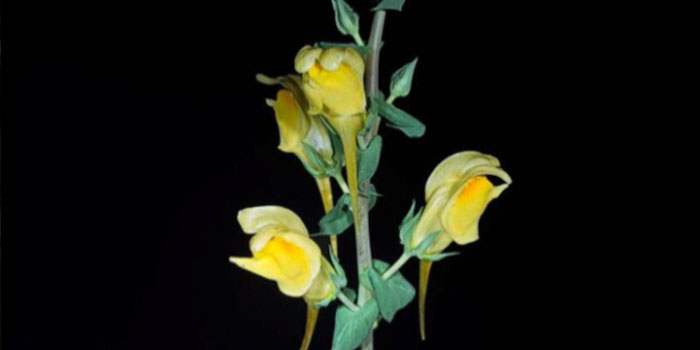
J.M. DiTomaso, The Regents of the University of California
+ Diffuse Knapweed
AGAPETA ZOEGANA
Agapeta zoegana, or the sulfur knapweed moth, is a biological control agent that attacks knapweed plants by tunneling into the cortex of the root. Adults are 0.4 inches long and usually emerge over a 12-week period from mid-June to early September and live for only several days in the field.
Females mate during the first 24 hours after emergence and begin laying eggs the following day. The adult moths are characterized by bright yellow wings with brown markings. Eggs are laid in small groups or singly on the surface of stems and leaves of knapweed, hatching in seven to 10 days. Larvae hatch and migrate to the crown where they mine the root and pupation then occurs within the root.
BANGASTERNUS FAUSTI
Bangasternus fausti, or the broad-nosed seed head weevil, emerges after overwintering as adults when plants are in the bud to mid-flowering stage, usually from May until late July. Adults are 0.14 inches long and are grayish-black with a much shorter snout than the Larinus spp. weevils.
Eggs are laid from May to mid-July under leaflets below developing flower heads or on the ends of stems and leaflets. New larvae either mine into the midrib of the leaflet or into the stem before tunneling into the flower head. Larvae can consume up to 100% of the seeds in a flower head and the viability of unattacked seeds is also reduced. The weevil prefers hot, dry areas and has limited effectiveness at high elevations and areas with prolonged rain. The weevils are usually collected with a sweep net in late spring when plants begin to bloom.
CYPHOCLEONUS ACHATES
Cyphocleonus achates, or the knapweed root weevil, is a robust biological control agent that can attack spotted (preferred host) and diffuse knapweeds. The insect overwinters as larvae in the root where the larvae mine and gall the vascular tissue. This larval feeding reduces knapweed density and can result in death of small plants.
Photo credit: Cornell UniversityAdults emerge from June to mid-September and feed on knapweed leaves. The adults are 0.5 to 0.6 inches long and generally live 8 to 15 weeks.
Females mate several times and deposit more than 100 eggs during their lifetime. Eggs are laid singly in a notch excavated by the female on the root crown just below the soil surface, hatching in 10 to 12 days.
LARINUS MINUTUS, L. OBTUSUS
Larinus spp., or the knapweed flower weevils, are abundant biological control agents that can utilize spotted, diffuse, and squarrose knapweeds. These insects overwinter as adults, and emerge in the spring when they begin to feed on knapweed foliage.
Females produce between 28 and 130 eggs which they lay in clusters in open flowers. The hatching larvae feed on seeds and receptacle tissues and later construct cocoons within the seedheads using pappus hairs.
Photo credit: USDA ARSAfter four weeks, pupation occurs within this cocoon. Emerging adults chew a characteristic round hole in the top of the cocoon that is visible when viewed from above.
SPHENOPTERA JUGOSLAVICA
Sphenoptera jugoslavlica, or the bronze knapweed root borer, adults emerge in July and are characterized by their metallic, dark reddish-brown appearance. Eggs are placed on the leaf axils of knapweed rosettes during July and August.
Newly hatched larvae feed in the leaf axils, and second instar larvae mine into the root. The larvae overwinter in the root and resume feeding the next year. Galls and tunnels are created by the larval mining and these are often filled with sawdust and frass from the larvae.The larval feeding significantly reduces knapweed biomass, seed output, and density. These beetles can be collected en masse in Oregon and Washington using a sweep net in mid-July in the early evening.
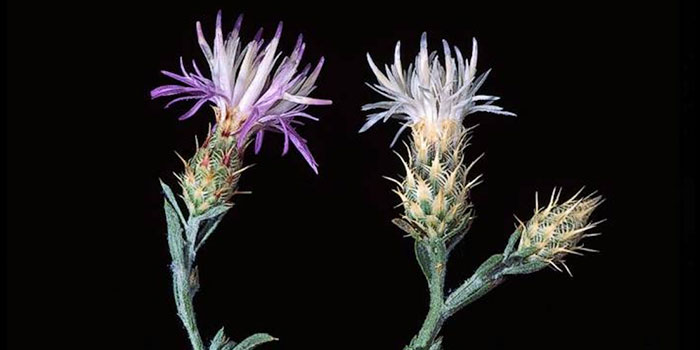
J.M. DiTomaso, The Regents of the University of California
+ Leafy Spurge
APHTHONA SPP.
The Aphthona species complex consists of six different species all with a similar biology. The larval stage is the most destructive whereby the larvae feed on fine and lateral spurge roots, impairing the roots and preventing moisture and nutrient uptake. Additionally, the root-feeding provides entry points for deleterious pathogens.
Aphthona spp. overwinter in the spurge roots as larvae which can be found from July to early spring of the following year. Pupation occurs in the soil near the plant with adult emergence occurring in June, July, and August.
Adult feeding damages the host and reduces the plant’s ability to make sugars for root reserves. The effective species in the genus Aphthona spp. are typically best suited for dry sites with a large amount of sun exposure. Recent studies suggest that these insects can also be used as a “bio-herbicide” in riparian areas as well. Apthona are hardy insects that can be stored for several days if packaged correctly. Initial releases into areas containing high ant or grasshopper populations should be avoided.
OBEREA ERYTHROCEPHALA
Adult Oberea erythrocephala, or the red-headed leafy spurge stem borers, are characterized by their red heads, black eyes, and slender bodies with antennae that are nearly as long as the body.
The males emerge several days before the females and both sexes are sexually immature for two weeks. Adults deposit eggs from the end of June to mid-July. Females often girdle the upper part of the stem, gnaw a hole into the stem above the girdle, and deposit an egg into the hole. Each female can produce approximately 60 eggs during her lifetime. The larvae hatch 10 days after oviposition and feed on the pith, tunneling downward toward the crown where they remain during the winter. The mined stems dry, wilt and do not produce flowers or seeds.
The destructive feeding in the crown and root reduces the plant’s root reserves and allows pathogenic fungi to enter the leafy spurge roots. This agent prefers mesic areas with trees and can survive subfreezing winter temperatures. They are easiest to collect during the morning hours with a sweep net or by hand. Some research suggests that this agent may be biotype specific – only attacking certain biotypes of leafy spurge.
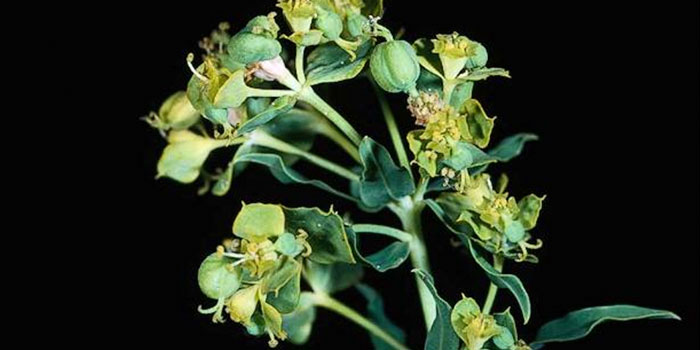
J.M. DiTomaso, The Regents of the University of California
+ Meadow Knapweed
LARINUS MINUTUS, L. OBTUSUS
Larinus spp., or the knapweed flower weevils, are abundant biological control agents that can utilize spotted, diffuse, and squarrose knapweeds. These insects overwinter as adults, and emerge in the spring when they begin to feed on knapweed foliage.
Females produce between 28 and 130 eggs which they lay in clusters in open flowers. The hatching larvae feed on seeds and receptacle tissues and later construct cocoons within the seedheads using pappus hairs.
After four weeks, pupation occurs within this cocoon. Emerging adults chew a characteristic round hole in the top of the cocoon that is visible when viewed from above.
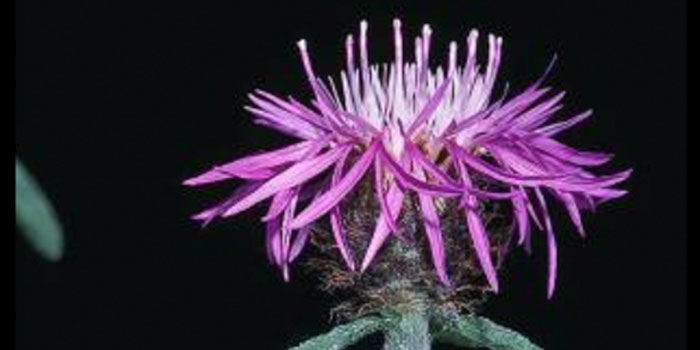
J.M. DiTomaso, The Regents of the University of California
+ Mediterranean Sage
PHRYDIUCHUS TAU
Phrydiuchus tau, or the Mediterranean sage root weevils, are characterized by the prominent white “T” on their backs. Adults emerge in late spring or early summer. After feeding on the foliage, they rest in summer aestivation until fall rains arrive and the plant begins to grow again.
Adult females lay eggs in the leaf axils, petioles, and on the undersides of rosette leaves. Eggs hatch 24 to 28 days after oviposition. Larvae tunnel through the leaves into the root crown, where larval development occurs.Mature larvae pupate in the surrounding soil from early May to July. Larval feeding in the root crown damages plants thereby reducing or preventing bolting, and in some cases kills the plant. Adults may impact the plant too, causing minor defoliation of rosette leaves.
Collections should be done in late spring or early summer using a sweep net or knocking them into a container. This agent does best at warm, dry sites and does not seem to establish at wetter sites and/or sites that receive snow before mid-November.
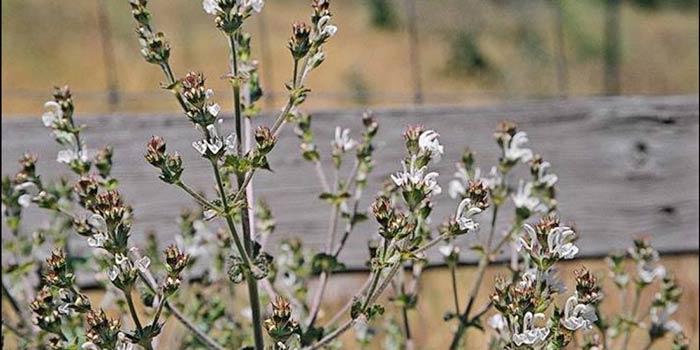
J.M. DiTomaso, The Regents of the University of California
+ Purple Loosestrife
GALERUCELLA SPP.
Galerucella spp., or the loosestrife beetles, may overwinter in the soil and surrounding vegetation. The adults typically emerge from hibernation, mate, and lay eggs from April through June. These agents are capable of producing two generations per year with new adults emerging and dispersing to additional locations in July and August.
Female adults lay eggs from May to June and again from August to September. Females can produce 300 to 400 eggs, laying up to 10 eggs per day in groups of three to six on stems, leaves, and leaf axils. Larvae and adults feed upon young buds and leaves, producing a “shotgun” appearance in the leaf material which, with heavy defoliation, skeletonizes and kills the plants.
These insects are best collected once egg-laying has begun in the early spring. They can be collected with sweep nets or hand-picking and should be released in groups of 250 to 500 adults.
HYLOBIUS TRANSVERSOVITTATUS
Hylobius transversovittatus, or the loosestrife root weevil, can overwiner as an egg, larva, pupa, or adult. Adults typically emerge in mid-to late summer and may live up to three years with females depositing about 300 eggs over a two-year period. One or two eggs are laid daily from June through August. The eggs are mostly deposited in the soil, but some are inserted into the stems just above the soil surface. The eggs hatch in 11 days and the larvae are normally present from August through June of the next year.
Larvae mine the roots and feeding tunnels are packed with light brown frass. Pupation occurs within the root during late spring to early summer. Both the adult and larval stages are destructive, but their impact depends upon plant root size, attack intensity, and duration.
This agent’s ideal habitat is a site without prolonged flooding, but it is able to withstand a wide range of environmental conditions. These weevils are easiest to collect at night, and can be reared with an artificial diet or from infested roots. When Hylobius is paired with Galerucella, their combined impacts seem to be very deleterious to purple loosestrife plants.
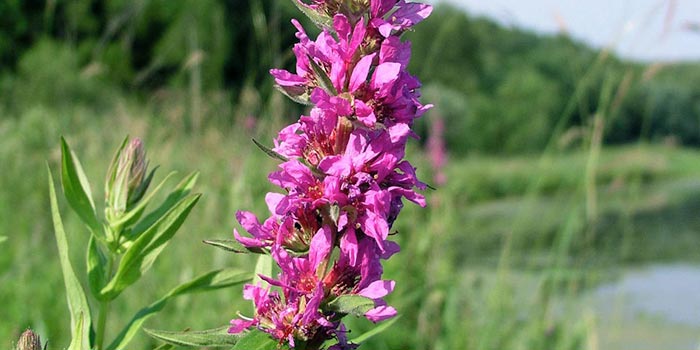
Linda Wilson, University of Idaho, Bugwood.org
+ Rush Skeletonweed
BRADYRRHOA GILVEOLELLA
Bradyrrhoa gilveolella, or the skeletonweed root moth, was recently approved for release. Adults emerge from exit tubes extending from the plant’s root in May and June. Females are capable of producing up to 300 eggs, laying them in the rosette crown or in the soil.
The eggs hatch in six to 10 days and the caterpillars penetrate the soil and begin to feed externally on the roots. The larvae feed both internally and externally on the root tissue, producing elongated tubes attached to the roots. These tubes are composed of frass, root fragments, sand grains, and latex from the plant. Larvae complete their development in 45 to 60 days in the tubes. Final instar larvae extend the exit tubes to the surface and pupate inside. Following their pupal stage, which lasts from seven to 10 days, adult moths force their way out of the capped exit tubes.
This insect is destructive in only the larval stage, when it destroys the cortical and vascular tissues of rush skeletonweed roots. The root feeding also exposes the plants to soilborne plant pathogens. Although establishment of this agent has not yet been confirmed, its preferred habitat (foreign collections) is sandy, granitic, or loose-textured soil.
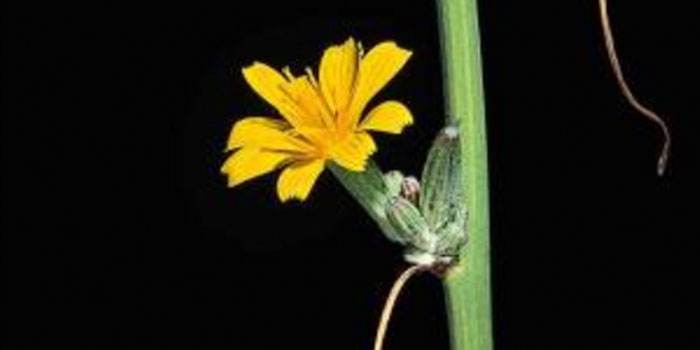
J.M. DiTomaso, The Regents of the University of California
+ Russian Knapweed
AULACIDEA ACROPTILONICA
Aulacidea acroptilonica, or the Russian knapweed gall wasp, is a recently approved biological control agent for Russian knapweed.
Adults emerge in early April and females lay eggs in the meristematic tissue, inducing gall development of main and lateral shoots. There is one generation per year which is strongly female biased.
JAAPIELLA IVANNIKOVI
Jaapiella ivannikovi, or the Russian knapweed gall midge, is another recently approved biological control agent for Russian knapweed. Female midges emerge in April and deposit their eggs on the surface of buds on the tips of the main and site shoots of Russian knapweed plants.
Larval feeding causes leaves to grow together and fuse, thereby stunting the shoot and creating a gall where larval development and pupation occur. Four to five partially overlapping generations, each lasting approximately one month, have been observed in the field.
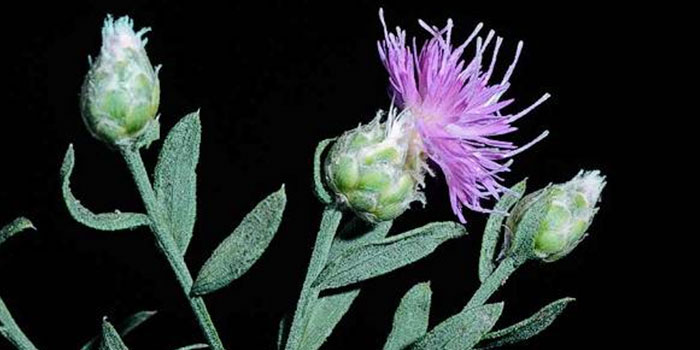
J.M. DiTomaso, The Regents of the University of California
+ Scotch Broom
BRUCHIDIUS VILLOSUS
Bruchidius villosus, or the Scotch broom bruchid, overwinters as adults away from the host plant. Adults become active when the plants begin to flower. Adults mate and the females oviposit between two and 12 eggs onto seed pods where they hatch in one to two weeks.
The larval stage is the destructive stage with larvae hatching and tunneling into the pod until they reach a seed, where they bore in and complete their development. After four larval instars, pupation occurs within the seed coat. The pupal period is temperature-dependent and takes between 10 and 20 days.
As the seed pods mature, they split open and free the adults. Seed destruction by the larvae has been documented at more than 80% in North Carolina, but locally the reduction rate has been reported at 10-25%.
To redistribute, collect adults after they have mated with heavy sweep nets with releases of 100 to 250 adults.
EXAPION FUSCIROSTRE
Exapion fuscirostre, or the Scotch broom seed weevil, overwinters as an adult in the duff near the host plant, however, adults can be found throughout the year feeding on terminal twigs. Females feed on flowers in the spring to stimulate egg production. Eggs are inserted into seed pods in groups of five to 10 where they hatch in five to 15 days. Larvae feed on the seeds in the seed pods, completing development in 20 to 40 days. The larvae then pupate within the seed pod in 10 to 20 days, with typically one pupa per seed.
Adults emerge when the seed pods dry and split open, flying to the yellow flowers of surrounding Scotch broom plants. This agent is destructive in the larval stage, attacking seeds, and as adults, feeding on terminal stems. Seed reduction in attacked seed pods averages 85%, although only 40 to 60% of seed pods are attacked in the field.
This agent prefers meadows and hillsides with southern exposures and is capable of dispersing up to 2 km per year once established. Collection can be done with a heavy-duty sweep net after the adults have mated (typically mid to late flower). Releases of 100 to 250 adults are recommended to establish the agents at a site.
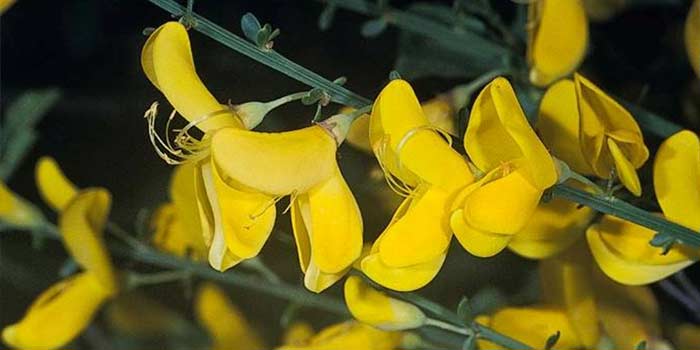
J.M. DiTomaso, The Regents of the University of California
+ Spotted Knapweed
AGAPETA ZOEGANA
Agapeta zoegana, or the sulfur knapweed moth, is a biological control agent that attacks knapweed plants by tunneling into the cortex of the root. Adults are 0.4 inches long and usually emerge over a 12-week period from mid-June to early September and live for only several days in the field.
Females mate during the first 24 hours after emergence and begin laying eggs the following day. The adult moths are characterized by bright yellow wings with brown markings. Eggs are laid in small groups or singly on the surface of stems and leaves of knapweed, hatching in seven to 10 days. Larvae hatch and migrate to the crown where they mine the root and pupation then occurs within the root.
BANGASTERNUS FAUSTI
Bangasternus fausti, or the broad-nosed seed head weevil, emerges after overwintering as adults when plants are in the bud to mid-flowering stage, usually from May until late July. Adults are 0.14 inches long and are grayish-black with a much shorter snout than the Larinus spp. weevils.
Eggs are laid from May to mid-July under leaflets below developing flower heads or on the ends of stems and leaflets. New larvae either mine into the midrib of the leaflet or into the stem before tunneling into the flower head. Larvae can consume up to 100% of the seeds in a flower head and the viability of unattacked seeds is also reduced. The weevil prefers hot, dry areas and has limited effectiveness at high elevations and areas with prolonged rain. The weevils are usually collected with a sweep net in late spring when plants begin to bloom.
CYPHOCLEONUS ACHATES
Cyphocleonus achates, or the knapweed root weevil, is a robust biological control agent that can attack spotted (preferred host) and diffuse knapweeds. The insect overwinters as larvae in the root where the larvae mine and gall the vascular tissue. This larval feeding reduces knapweed density and can result in death of small plants.
Adults emerge from June to mid-September and feed on knapweed leaves. The adults are 0.5 to 0.6 inches long and generally live 8 to 15 weeks.
Females mate several times and deposit more than 100 eggs during their lifetime. Eggs are laid singly in a notch excavated by the female on the root crown just below the soil surface, hatching in 10 to 12 days.
LARINUS MINUTUS, L. OBTUSUS
Larinus spp., or the knapweed flower weevils, are abundant biological control agents that can utilize spotted, diffuse, and squarrose knapweeds. These insects overwinter as adults, and emerge in the spring when they begin to feed on knapweed foliage.
Females produce between 28 and 130 eggs which they lay in clusters in open flowers. The hatching larvae feed on seeds and receptacle tissues and later construct cocoons within the seedheads using pappus hairs.
After four weeks, pupation occurs within this cocoon. Emerging adults chew a characteristic round hole in the top of the cocoon that is visible when viewed from above.
SPHENOPTERA JUGOSLAVICA
Sphenoptera jugoslavlica, or the bronze knapweed root borer, adults emerge in July and are characterized by their metallic, dark reddish-brown appearance. Eggs are placed on the leaf axils of knapweed rosettes during July and August.
Newly hatched larvae feed in the leaf axils, and second instar larvae mine into the root. The larvae overwinter in the root and resume feeding the next year. Galls and tunnels are created by the larval mining and these are often filled with sawdust and frass from the larvae.The larval feeding significantly reduces knapweed biomass, seed output, and density. These beetles can be collected en masse in Oregon and Washington using a sweep net in mid-July in the early evening.
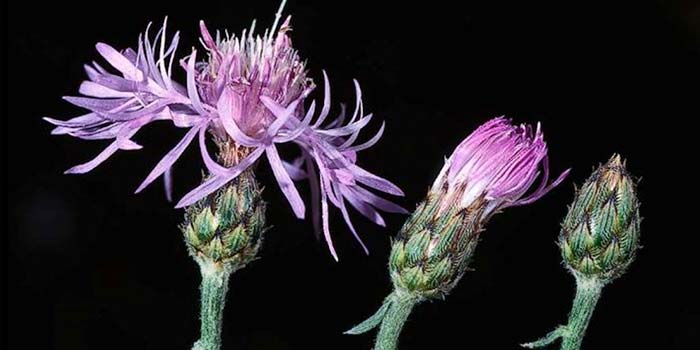
J.M. DiTomaso, The Regents of the University of California
+ Squarrose Knapweed
BANGASTERNUS FAUSTI
Bangasternus fausti, or the broad-nosed seed head weevil, emerges after overwintering as adults when plants are in the bud to mid-flowering stage, usually from May until late July. Adults are 0.14 inches long and are grayish-black with a much shorter snout than the Larinus spp. weevils.
Eggs are laid from May to mid-July under leaflets below developing flower heads or on the ends of stems and leaflets. New larvae either mine into the midrib of the leaflet or into the stem before tunneling into the flower head. Larvae can consume up to 100% of the seeds in a flower head and the viability of unattacked seeds is also reduced. The weevil prefers hot, dry areas and has limited effectiveness at high elevations and areas with prolonged rain. The weevils are usually collected with a sweep net in late spring when plants begin to bloom.
LARINUS MINUTUS, L. OBTUSUS
Larinus spp., or the knapweed flower weevils, are abundant biological control agents that can utilize spotted, diffuse, and squarrose knapweeds. These insects overwinter as adults, and emerge in the spring when they begin to feed on knapweed foliage.
Females produce between 28 and 130 eggs which they lay in clusters in open flowers. The hatching larvae feed on seeds and receptacle tissues and later construct cocoons within the seedheads using pappus hairs.
After four weeks, pupation occurs within this cocoon. Emerging adults chew a characteristic round hole in the top of the cocoon that is visible when viewed from above.
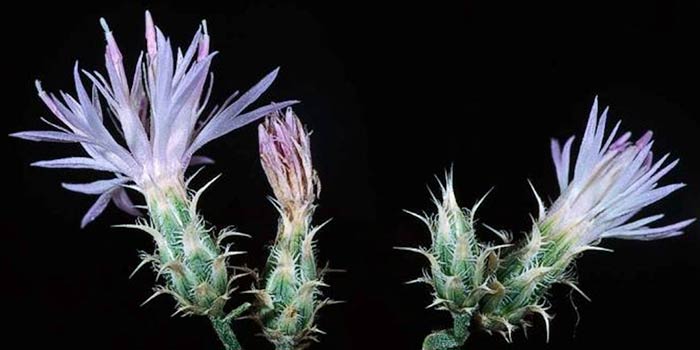
J.M. DiTomaso, The Regents of the University of California
+ Tansy Ragwort
LONGITARSUS JACOBAEAE
Longitarsus jacobaeae, or the tansy ragwort flea beetle, is destructive in both the larval and adult stages. The adults emerge briefly in the spring and then rest during the hotter summer months. After fall rain storms, the adults again become active and begin mating in the fall.
The two established biotypes (Swiss and Italian) have different life cycles. The Italian strain lays eggs during October and November. The Swiss strain lays eggs in the spring and adults emerge from pupae in midsummer and immediately lay eggs that remain dormant during summer and fall finally hatching in the spring, beginning the life cycle anew.
The larvae of both biotypes hatch in approximately two weeks and feed on the roots of the target plant. Pupation occurs in the soil beginning in the spring for the Italian biotype and the fall for the Swiss biotype. The larval root feeding and adult defoliation combine to control up to 90% of the target plants over a six year period.
Redistribution efforts should be done using an insect-collecting vacuum on large rosettes after the first fall rains. Summer collections can also be done using sweep nets. It is best to release this agent in sunny pastures and in groups of 100 to 500.
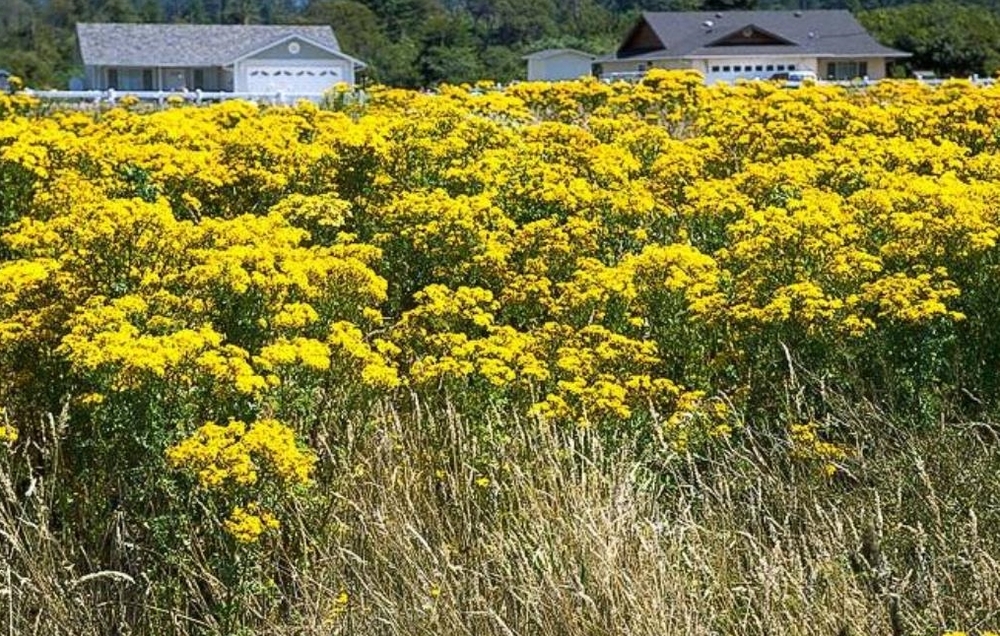
J.M. DiTomaso, The Regents of the University of California
+ Yellow Starthistle
BANGASTERNIS ORIENTALIS
Bangasternus orientalis, or the yellow starthistle bud weevil, reduces seed production of yellow starthistle plants by 50 to 60%. Adults cause minor defoliation, with the majority of the damage caused by larval feeding.
Adults overwinter outside the host plant, leaving their pupal chambers in the seed head in late summer. Females may produce up to 470 eggs, laying them singly on or near scale leaves beneath the immature buds of flowering shoots in late spring to early summer. Larvae hatch and tunnel through the scale leaf, the flower stalk, and into the seed head where they feed on bracts, receptacle tissue, and developing seeds. The weevil pupates within the seed head in chambers formed from damaged and undamaged seeds. This weevil is very widespread and can be collected via sweep net or hand picking in the spring or early summer.
EUSTENOPUS VILLOSUS
Eustenopus villosus, or the yellow starthistle hairy weevil, attacks the seed heads of yellow starthistle reducing seed production by 90 to 100%. Adult weevils emerge in late May and persist through August.
Females lay eggs inside mature, closed buds in early to mid summer. Females chew a hole in the side of the seed head for oviposition, sometimes causing the flower head to become distorted. Larvae hatch in three days and develop in 16 days, feeding on the receptacle and developing seeds. The pupal stage takes eight to 13 days and occurs within the seed head in a chamber composed of chewed seeds and pappus hairs.
In addition to the damage caused by the larval feeding in the seed head, the adults feed on small seedhead buds, usually destroying a high percentage, and on mature buds. The weevil is widespread throughout most of the west and can be collected with a sweep net from host plants in early summer.
LARINUS CURTUS
Larinus curtus, or the yellow starthistle flower weevil, can reduce seed production up to 100%. Adults occur from June to early August and feed on flowers and pollen. The weevil may be covered in pollen and they can typically be found with their heads buried deep into flowers leaving their posteriors exposed.
Adult females lay their eggs at the base of flowers and in heads with open flowers. Larvae hatch in four days and begin feeding on developing seeds, completing development in 17 to 20 days. Pupation occurs in four to five days within chambers formed in the seed heads. The larval stage is the destructive stage, although adult feeding on flowers and pollen may have a small impact on the plant. Adults can be collected by hand-picking or sweep nets when flowering plants are at 10% bloom.
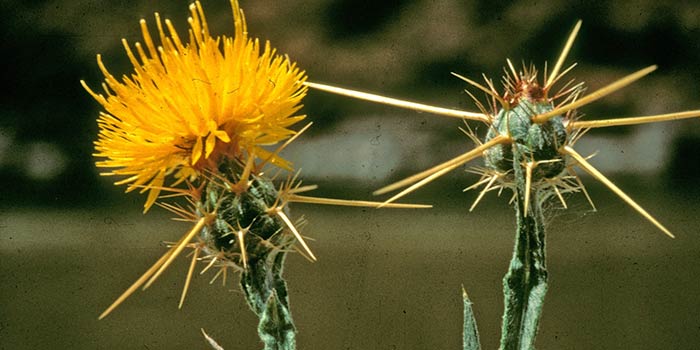
Steve Dewey, Utah State University, Bugwood.org
+ Yellow Toadflax
MECINUS JANTHINUS
Adult Mecinus janthinus, or the toadflax stem weevil, are small, somewhat elongated bluish black weevils which emerge from last year’s Dalmatian toadflax stems in April-May. Adults feed on leaves and stems before mating and laying eggs inside new shoots from June to mid-July.
The incubation period is typically six to seven days. Adults target stems that are at least 0.9 mm in diameter and are active into July.The eggs hatch and larvae tunnel within the stem as they feed, moving no more than 30 mm from where the egg was laid before pupating. Larval development takes between 23 and 34 days.
Pupation occurs within the stem. Adult feeding on stems and leaves has a limited effect on the plant, but larval mining impacts the plants causing premature wilting of shoots and suppressing flower formation. Mecinus overwinter as adults inside their pupation chamber. The effects of the weevil on the plant are reportedly enhanced under drought stress. Adults can be collected using an aspirator or sweep net while they are feeding and ovipositing.
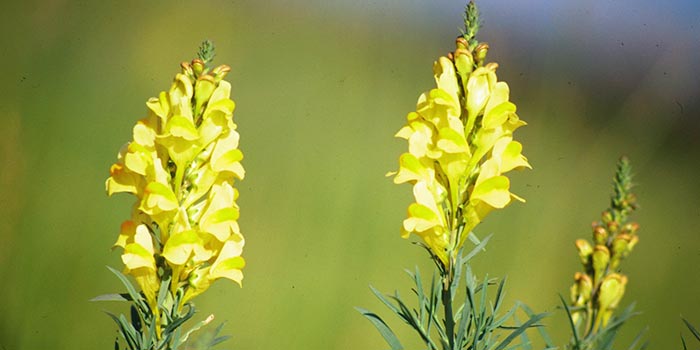
Steve Dewey, Utah State University, Bugwood.org
Cyphocleonus achates on spotted knapweed
Photo: (Cyphocleonus achates) Mark Schwarzlander, University of Idaho.

